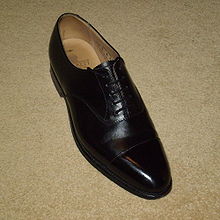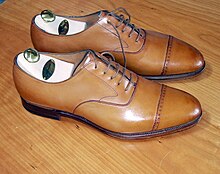
A shoe is an item of footwear intended to protect and comfort the human foot. Though the human foot can adapt to varied terrains and climate conditions, it is vulnerable, and shoes provide protection. Form was originally tied to function, but over time, shoes also became fashion items. Some shoes are worn as safety equipment, such as steel-toe boots, which are required footwear at industrial worksites.
Slip-ons are typically low, lace-less shoes. The style which is most commonly seen, known as a loafer, slippers, or penny loafers in American culture, has a moccasin construction. One of the first designs was introduced in London by Wildsmith Shoes, called the Wildsmith Loafer. They began as casual shoes, but have increased in popularity to the point of being worn in America with business suits. Another design was introduced as Aurlandskoen in Norway.
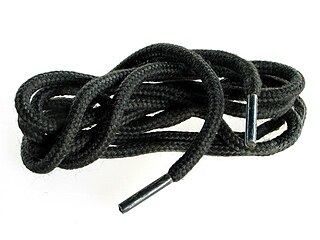
Shoelaces, also called shoestrings or bootlaces, are a system commonly used to secure shoes, boots, and other footwear. They typically consist of a pair of strings or cords, one for each shoe, finished off at both ends with stiff sections, known as aglets. Each shoelace typically passes through a series of holes, eyelets, loops or hooks on either side of the shoe. Loosening the lacing allows the shoe to open wide enough for the foot to be inserted or removed. Tightening the lacing and tying off the ends secures the foot firmly within the shoe. The laces can be tied in different shapes, most commonly a simple bow.

Morning dress, also known as formal day dress, is the formal Western dress code for day attire, consisting chiefly of, for men, a morning coat, waistcoat, and formal trousers, and an appropriate gown for women. Men may also wear a popular variant where all parts are the same colour and material, often grey and usually called "morning suit" or "morning grey" to distinguish it; considered properly appropriate only to festive functions such as summer weddings and horse races, which consequently makes it slightly less formal. The correct hat would be a formal top hat, or if on less spacious audience settings optionally a collapsible equivalent opera hat.

Highland dress is the traditional, regional dress of the Highlands and Isles of Scotland. It is often characterised by tartan. Specific designs of shirt, jacket, bodice and headwear may also be worn along with clan badges and other devices indicating family and heritage.

The brogue is a style of low-heeled shoe or boot traditionally characterised by multiple-piece, sturdy leather uppers with decorative perforations and serration along the pieces' visible edges.

A court shoe or pump is a shoe with a low-cut front, or vamp, with either a shoe buckle or a black bow as ostensible fastening. Deriving from the 17th- and 18th-century dress shoes with shoe buckles, the vamped pump shape emerged in the late 18th century. By the turn of the 19th century, shoe buckles were increasingly replaced by black bows, which has remained the contemporary style for men's formal wear, leather or patent leather evening pumps ever since. This latter style is sometimes also called an opera pump or opera slipper.

The spectator shoe, also known as co-respondent shoe, is a style of low-heeled, oxford, semi-brogue or full brogue constructed from two contrasting colours, typically having the toe and heel cap and sometimes the lace panels in a darker colour than the main body of the shoe. This style of shoe dates from the nineteenth century but reached the height of popularity during the 1920s and 1930s.

A moccasin is a shoe, made of deerskin or other soft leather, consisting of a sole and sides made of one piece of leather, stitched together at the top, and sometimes with a vamp. The sole is soft and flexible and the upper part often is adorned with embroidery or beading. Though sometimes worn inside, it is chiefly intended for outdoor use.

A dress shoe is a shoe to be worn at smart casual or more formal events. A dress shoe is typically contrasted to an athletic shoe.
This is a list of existing articles related to fashion and clothing. For individual designers, see List of fashion designers
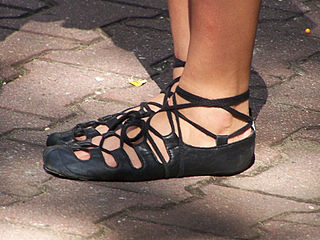
Ghillies are specially designed shoes used for several types of dance. They are soft shoes, similar to ballet shoes. They are used by women in Irish dance, by men and women in Scottish country dance, and by men and women in Scottish highland dance.

Chukka boots are ankle-high leather boots with suede or leather uppers, leather, wooden or rubber soles, and open lacing, with two or three pairs of eyelets. The name chukka possibly comes from the game of polo, where a chukka is a period of play.
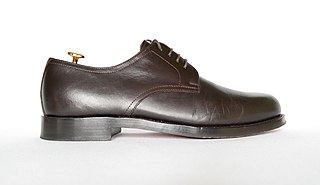
A derby is a style of boot or shoe characterized by quarters, with shoelace eyelets, that are sewn on top of the vamp. This construction method, also known as "open lacing", contrasts with that of the Oxford shoe.
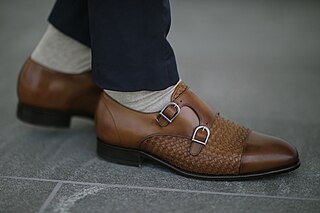
A monk shoe or monk strap is a style of dress shoe with no lacing, instead secured on the feet by one or multiple buckles and straps. It was innovated by the English shoe maker, Edward Green in the late 19th century.

Dress boots are short leather boots typically worn by men. Built like dress shoes, but with uppers covering the ankle, versions of the boots are used as an alternative to these in bad weather or rough outdoor situation, and as a traditional option for day time formalwear.

A blucher is a style of shoe with open lacing, its vamp made of a single piece of leather, with shoelace eyelets tabs sewn on top.

British country clothing or English country clothing is the traditional attire worn by men and women in rural Britain; it is the choice of clothing when taking part in outdoor sports such as equestrian pursuits, shooting or fishing and during general outdoor activity, such as walking, picnicking, or gardening. It is also worn at events such as horse races, country weddings, beer festivals and country fairs.
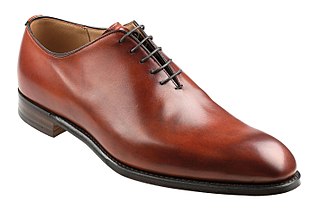
In shoemaking, wholecut shoes are shoes which are made from a single piece of flawless leather with or without a backseam—in the latter case it is called a seamless wholecut. These shoes can be entirely plain and smooth or with tiny perforated decorations. Various types of shoes can be made wholecut, but usually the term refers to classic dress shoes. The absence of decorative features and overall conservative look tend to make wholecuts appropriate for black-tie occasions.
